Fri 19 Nov 2010
How to get a OSHA Inspection
Posted by admin under MSHA, OSHA
Comments Off on How to get a OSHA Inspection
Fri 19 Nov 2010
Posted by admin under MSHA, OSHA
Comments Off on How to get a OSHA Inspection
Tue 16 Nov 2010
Posted by admin under Drywall, Paper Dust Masks, Personal Protective Equip (PPE), Respirators, Silica
[3] Comments
I have done a bunch of respirable silica dust air monitoring during drywall sanding activities. 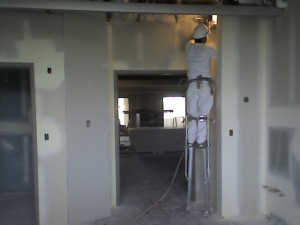 I have found varying results from the data (meaning overexposures & within the exposure limits). I have found silica in the drywall mud (or possibly the drywall itself). I have also found that most drywall sanders wear a paper dust mask. In recent years I have not found any airborne silica in my samples. However! I have found airborne (total) dust levels higher than five times the exposure limits during sanding. What does this mean?
I have found varying results from the data (meaning overexposures & within the exposure limits). I have found silica in the drywall mud (or possibly the drywall itself). I have also found that most drywall sanders wear a paper dust mask. In recent years I have not found any airborne silica in my samples. However! I have found airborne (total) dust levels higher than five times the exposure limits during sanding. What does this mean?
Well, the issue is that most drywall sanders use paper dust masks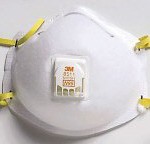 , or equivalent N95 or P100. Like this.
, or equivalent N95 or P100. Like this.
NIOSH has rated these masks for a protection factor of 5. Meaning that you are “allowed” to be exposed up to 5 times the exposure limit. IMO there are many things wrong with these masks. For starters, their fit on your face is really a guess. There are no “tried-and-true” methods for assuring these masks fit.*Â Second, if you admit that you need to wear a respirator (meaning: you need to protect yourself) why would you choose an inferior product? I could go on…
Therefore, or finally, we come to my recommendations:
Besides who wants to look like this at the end of the day?
*Quantitative fit testing is a reliable fit test method, but for these types of masks, I find it to be totally useless in the real-world
Wed 10 Nov 2010
Posted by admin under Asbestos, Training
[5] Comments
Who needs it? And what are the requirements?
IMO every contractor who works on buildings built before 1985 needs it. I know, the rules say buildings 1980 and earlier, but asbestos has been found in buildings built after 1980. So what kind of training do you need? Well, that depends.
If you work on buildings built before 1985 you will need at least Class IV training. The definition (by OSHA) of Class IV activity is “maintenance and custodial activities during which employees contact but do not disturb asbestos containing materials and activities to clean up dust, waste and debris resulting from Class I, II and III activities“. I believe this includes all construction activities where there might be asbestos present. Even if the plan is to stop-work, and call the abatement company.
Class III definition is, “– means repair and maintenance operations, where asbestos containing material, including thermal system insulation and surfacing asbestos containing material is likely to be disturbed“. I can think of many instances where contractors touch and disturb asbestos including, HVAC (Mechanical), Plumbers, Electricians and others.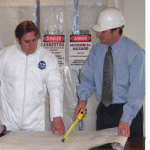
Classes I and II are strictly abatement activities and, for our purposes, we will not define, or get into.
Comparing Class III and Class IV, we see the real difference is if there is: 1. contact or 2. disturbance.
Depending on the construction activities on the structure- will determine which class you’re in…and will determine what type of training you will need.
Class III Training- 16 hours in length, and includes hands on use. Also, as a side- you must also register your project with EPA, depending on the size and type of activity.
Class IV Training- 2 hours in length, and must cover certain assigned topics.
Fri 5 Nov 2010
Posted by admin under Engineering Controls, Noise, Respirators, Silica
[3] Comments
Asphalt milling machines are used to remove road asphalt in wide sections. It has been awhile since I’ve had the opportunity to perform air monitoring for silica on these operations. 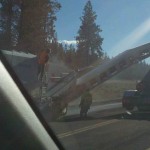 However, my experience in the past tells me that they can produce a lot of respirable silica dust. I snapped this picture while I was driving (I was going slow, but yea- probably not safe) on a road crew working. I didn’t capture the cloud of dust hitting the sunlight, but it was a beautiful/scary sight.
However, my experience in the past tells me that they can produce a lot of respirable silica dust. I snapped this picture while I was driving (I was going slow, but yea- probably not safe) on a road crew working. I didn’t capture the cloud of dust hitting the sunlight, but it was a beautiful/scary sight.
The drums on the asphalt machines have many sharp teeth. The drum is lowered onto the asphalt surface and basically chews up the asphalt while carrying it to a belt. 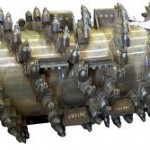 As you can imagine, the drum gets really hot. Water is kept on board the milling machine to cool the drum. The theory is that the drum is wet, so the silica issue must be at a minimum. I have found really high exposures to airborne respirable silica during this process. I believe due to the water NOT being directed at the cutting teeth.
As you can imagine, the drum gets really hot. Water is kept on board the milling machine to cool the drum. The theory is that the drum is wet, so the silica issue must be at a minimum. I have found really high exposures to airborne respirable silica during this process. I believe due to the water NOT being directed at the cutting teeth.
The solution? Unfortunately, I don’t have an easy one. For starters, I’d make sure the water is directed at the point of cutting (which can vary from day to day). Respirator are not really an option. The road crew must communicate with each other and doing this with a respirator is extremely hard. The noise from these operations is also very high and most crews have ear muffs with communication head-sets.
I would love to hear your comments on engineering solutions to this issue. I don’t believe there is much research going into this issue.
Thu 4 Nov 2010
I was at another rock crushing site this week. This company has a mobile crusher that can crush some nice sized rocks. Which, by the way, is unique, since most crushers that can handle these size rocks take various cones, belts and screens. Air sampling conditions were definitely not “worst case” due to morning mist and cloudy conditions for almost the entire day. However, any dust that was generated was most likely from the crusher- not gravel trucks, haul trucks, or wind. We did perform airborne silica monitoring and noise dosimetry on the crushing crew.
I did emphasize some easy, but usually overlooked, tips for the crew: